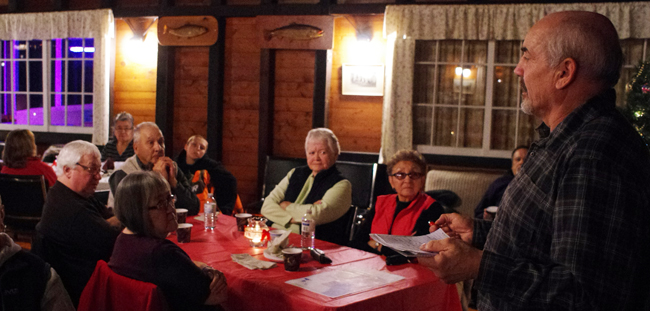Red Rock Community Profile: Renovated lodge key element of business plans

By Rick Garrick
The Red Rock Indian Band is looking to benefit from a recently-announced suspension bridge project by opening the Chalet Lodge for business.
“The bridge (they) are building here is going to be a one-of-a-kind in Canada,” says Red Rock Councillor Omer Belisle about the $106 million four-year bridge project on Highway 11/17. “It’s going to be a stopper for tourism, so the Chalet Lodge plays ideally right in that location.”
The Robinson Superior community, located about 120 kilometres east of Thunder Bay, plans to renovate five of the lodge’s cabins to accommodate bridge construction workers during the four-year construction period. Ten new cabins will also be built in the future.
“The accommodation availability between Nipigon and here is almost zero,” Belisle says. “There is nothing out there you can rent or buy, so the faster we can build these cabins up and get them insulated and heated, the better.”
In addition to renovating the cabins, the community of about 350 on-reserve and 1,350 off-reserve citizens plans to renovate and open the Chalet Lodge restaurant for business.
“We’re upgrading our restaurant to commercial capacity and we know people are waiting to use that too,” says Red Rock Councillor Ed Wawia. “I think with just our people alone we will be able to run a restaurant.”
Red Rock bought the 22-acre Chalet Lodge property in 2008 and has since been working to get it transferred to the reserve. Originally built by a railway company in the 1920s and later operated as a tourist resort, the lodge is located adjacent to the southwest corner of the reserve.
“The area is so beautiful — I don’t think there is another spot like this overlooking Lake Helen and the Nipigon River,” Wawia says. “When I was a kid, they had 38 cabins here at one time and they were always full.”
Wawia says the five cabins were built with the same high-quality materials as the main lodge building.
“They’re exactly the same as the inside of the main lodge,” Wawia says. “They’re all made of B.C. fir and they have hardwood floors. Each cabin right now just has a sink and a toilet; we’re going to add a shower to each cabin so they will be self-sufficient.”
Red Rock Chief Pierre Pelletier says the lodge is going to be the “hub” of the community’s economic development plans.
“We feel this can be a very good business,” Pelletier says. “Years ago people would come and spend a week here. Long term we will have boat rentals and fishing guides.”
Re-elected as chief in September after a two-year hiatus, Pelletier is focusing on economic development and job creation.
“We’re going to be job-focused to get the people working,” Pelletier says. “We’re going to create our own source of revenue. Without our own source of revenue, we are just going to exist under the thumb of INAC (Aboriginal Affairs and Northern Development Canada). This way here, we are going to look at creating our own so the band will flourish.”
Red Rock is currently planning to build a new business complex-band office on Highway 11 and is also looking into the feasibility of operating the Ruby Lake marble quarry, which is located about six kilometres south-east of the community.
“It was recommended that we drill another two to three holes to ensure that viability is there,” says Red Rock Councillor Kristine Baccar about the quarry. “We (have since) received a call from an interested buyer for some of the surface (marble) at the top of the quarry. He is asking for about 40 tons of that marble that is already there.”
The community also acquired 660 acres of land situated on the far side of Highway 17 next to the Nipigon River after signing an agreement in 2011 for economic losses stemming from an Ontario Hydro development.
“We’re getting a lot of community involvement and people are getting excited to see things happening,” Pelletier says. “With the new band office coming, I think it’s going to really stimulate the band to join together and move ahead.”
Red Rock had previously entered into the office leasing business by providing Dilico Anishinabek Family Care with accommodations at the former Elks Hall in Nipigon in 2008 and the former Heath Park School in Thunder Bay in 2010.
“There is a lot of pride in our community now — we own things,” says Frances Hicknell, who has lived in the community since the 1950s. “We own a Dilico office in Thunder Bay and we own one here in Nipigon. And we own an office building in Red Rock (a town located about 20 kilometres west of the Red Rock reserve).”
Hicknell says there were a lot of hardships in the community when she was growing up.
“We just didn’t go out any place – we stayed close to home,” Hicknell says. “But now there is hockey in Nipigon, curling. There are a lot of things that our people get into now. Most of our grandchildren now play hockey and they go out to play in Marathon and Red Rock.”
Red Rock currently has about 60 elementary and 30 secondary students attending school in Nipigon, located about three kilometres to the southwest.
“We’ve had very good success,” Belisle says, noting community members who work in law, education, medicine and policing. “There are some that fall by the wayside, and that is our job as chief and council to address the inadequacies that we have and how we are going to get these children through school with an education level that they can work with and be independent.”
Red Rock has 950 acres of reserve land, which includes Parmacheene Reserve 53 and Lake Helen Reserve 53A. The community currently has about 100 houses, with three built over the past two years.


